Physical Address
304 North Cardinal St.
Dorchester Center, MA 02124
Transabdominal sonography (TAS) and transvaginal sonography (TVS) are often complementary, providing different diagnostic information. TAS provides a wider field of view and better visualization of superficial structures and large pelvic masses but has limited resolution. The transvaginal approach allows the probe to be placed closer to the “target organs,” providing higher resolution imaging, but has a limited field of view.
Because of the ability to use higher frequency probes, TVS usually provides the best anatomic detail. Therefore, TVS is considered the optimal sonographic technique with the highest diagnostic yield and should be incorporated into the sonographic examination of the female pelvis unless there are reasons that the transvaginal approach should be avoided.
Not all patients are appropriate candidates for transvaginal examination. The examination should not be performed on any patient who does not or cannot willingly consent to the procedure, as well as on most virginal patients and those who experience marked discomfort with probe insertion.
The appearance of the normal endometrium and ovary varies significantly throughout the menstrual cycle in women of reproductive age. It is important to be cognizant of the expected changes in order to avoid misinterpreting physiologic changes as pathologic.
Transperineal, translabial, and transrectal sonography should be considered alternative approaches for imaging the female pelvis and are particularly useful for evaluation of the postmenopausal uterus, the cervix, and the lower urinary tract.
Pelvic sonography is considered the initial imaging tool of choice for assessing suspected gynecologic disorders in patients of all ages. Sonography offers the advantages of widespread availability, low cost, and lack of exposure to ionizing radiation and is often the only imaging examination necessary for diagnosis of uterine, ovarian, and adnexal disease. In addition, sonography is extremely useful in the evaluation of pathologic changes affecting the pelvic portions of the urinary system, gastrointestinal tract, and musculoskeletal structures that may mimic the clinical presentation of gynecologic disease. In many ultrasound laboratories, the standard protocol for ultrasound examination of the female pelvis begins with TAS using the filled urinary bladder as the acoustic window, followed by TVS after emptying the bladder and placing the patient in the lithotomy position. The two imaging techniques are complementary, often providing different diagnostic information. TAS provides a wider field of view than the transvaginal approach and provides better visualization of superficial structures and structures remote from the vagina. However, by placing the probe closer to the “target organs,” the transvaginal approach requires less depth of penetration and bypasses the attenuating soft tissues overlying the pelvic organs, allowing utilization of a higher frequency probe, which provides higher resolution and anatomic detail of the uterus, ovaries, and adnexa ( Fig. 26-1 ). The normal sonographic anatomy described in this chapter reflects a combined transabdominal and transvaginal approach and is weighted, as in clinical practice, to emphasize the positive attributes of both TVS and TAS.
High-resolution TVS has been widely available since the mid-1980s and is considered an integral part of gynecologic as well as early obstetric sonographic examinations. TVS typically provides more anatomic detail of the uterus, endometrium, ovaries, and adnexa than does TAS. This is because the probe is placed closer to the organs of interest and requires less depth of penetration; therefore, a higher frequency probe with ensuing higher resolution can be utilized ( Figs. 26-2 and 26-3 ).
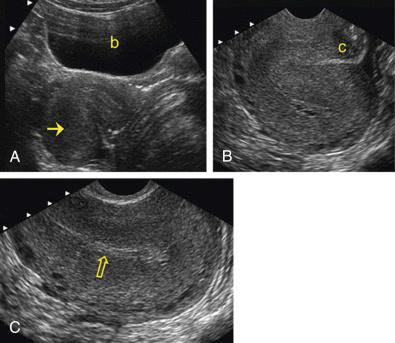
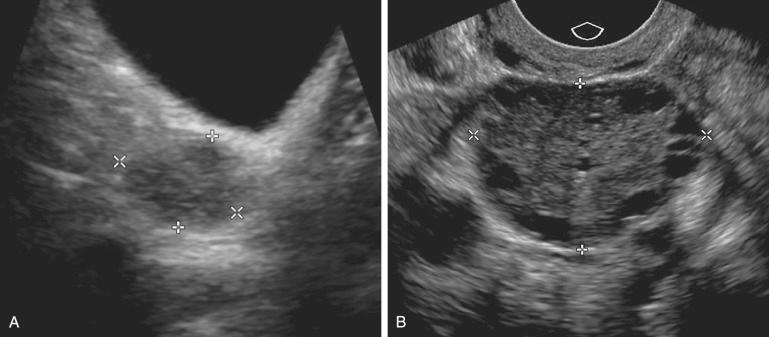
An additional advantage of TVS is the capability of using the probe tip to assess pelvic structures for tenderness. By applying gentle pressure with the transducer tip to pelvic structures, it is possible to localize the region of tenderness with greater specificity than with TAS or bimanual examination. Hence, TVS is considered the optimal sonographic technique for imaging the female pelvis and should be incorporated into the sonographic examination in all situations for which it will provide additional clinically useful diagnostic information, barring contraindications to the transvaginal approach (see later).
Indications for pelvic sonography include but are not limited to the following :
Evaluation of pelvic pain and pelvic masses
Evaluation of endocrine abnormalities, including polycystic ovaries
Evaluation of dysmenorrhea, amenorrhea, abnormal vaginal bleeding, and delayed menses
Evaluation, monitoring, and treatment of infertility patients
Evaluation of pelvic anatomy in the setting of a limited clinical examination
Evaluation of suspected pelvic infection
Further characterization of a pelvic abnormality noted on another imaging study
Evaluation of congenital uterine and lower genital tract anomalies
Evaluation of excessive bleeding, pain, or signs of infection after pelvic surgery, delivery, or abortion
Localization of an intrauterine contraceptive device
Screening for malignancy in high-risk patients
Evaluation of incontinence or pelvic organ prolapse
Evaluation for possible ectopic pregnancy
Evaluation of a first trimester gestation for viability, growth, and anomalies
Evaluation of the placenta, cervix, and other pelvic structures in second and third trimester gestations
Evaluation of fetal anatomy in second and third trimester gestations
Guidance for interventional or surgical procedures
However, not all patients are appropriate candidates for TVS. The transvaginal examination should not be performed in any patient who does not or cannot willingly consent to the procedure. There may be cultural, religious, or social reasons why TVS is inappropriate. In addition, TVS is rarely recommended in premenarchal or virginal patients, and if deemed necessary, it should be performed only after careful discussion with the individual and parent or guardian, as appropriate. If a patient experiences anxiety or discomfort at the time of attempted probe insertion (e.g., in the setting of a narrow introitus or vaginal abnormality such as atrophic or inflammatory vaginitis), termination of the transvaginal portion of the examination is recommended. It may be helpful to allow the patient to insert the probe herself. In many postmenopausal women, TVS is required to adequately image the endometrium and ovaries, because the TAS examination may be compromised by a variety of senescent changes, including decreased urinary bladder capacity, increased body habitus, an atrophic and ill-defined endometrium, and small ovarian size. Fortunately, postmenopausal patients tolerate the transvaginal examination well, with an overall patient acceptance rate that is only slightly less than that in women of reproductive age. Transrectal sonographic imaging may be performed as an alternative to TVS to image the uterus and adnexal structures in postmenopausal women with their consent. Transperineal and translabial scanning can be used in patients who are not candidates for the transvaginal approach and is also useful for evaluation of pelvic organ prolapse, as well as of the cervix and the lower urinary tract ( Fig. 26-4 ). TVS may also be contraindicated in some second and third trimester obstetric patients with active bleeding or ruptured membranes.
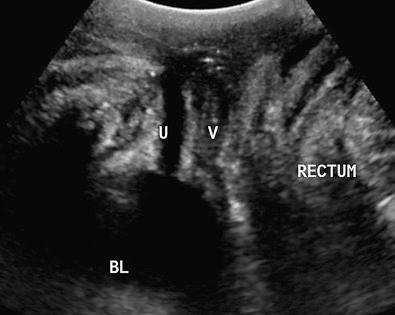
Although TVS offers superior resolution to TAS, TVS maybe compromised by sound attenuation (e.g., by large or calcified leiomyomas in the lower uterus) or by positioning of the ovaries or other lesions high in the pelvis beyond the field of view of the transvaginal probe. Large uterine size and fixation of the uterus to the anterior abdominal wall by adhesions, such as after cesarean delivery, can also limit the ability of TVS to assess the entire uterus for pathologic change or to perform accurate measurements. In these situations, TAS provides a wider field of view than the transvaginal approach and thus allows better visualization of structures in the upper pelvis or in a superficial location. Furthermore, TAS can provide a more panoramic view of the entire pelvis, which is helpful in the setting of a large pelvic mass ( Fig. 26-5 ). TAS also allows assessment of related intra-abdominal disease and structures, such as quantification of free intraperitoneal fluid in the hepatorenal space and paracolic gutters, hydronephrosis in the setting of a large pelvic mass or malignancy, and, more rarely, identification of peritoneal implants.
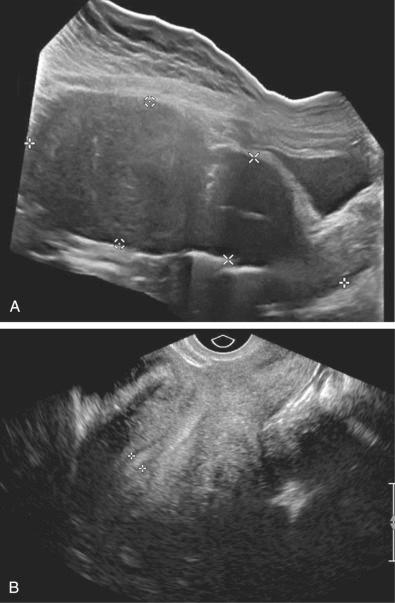
Protocols for pelvic sonography vary between institutions and can be tailored according to the specific clinical indication. In some institutions, it is routine to perform a complete transabdominal pelvic sonogram using the distended urinary bladder as an acoustic window, followed by a complete transvaginal pelvic sonogram with an empty bladder. In other institutions, women are not asked to fill their bladders before routine pelvic sonograms, but initially have a limited transabdominal examination, irrespective of the fullness of the urinary bladder, to screen for large pelvic masses and to measure the uterus. Subsequently, the patient is asked to void and a complete transvaginal sonogram is performed. At other sites, patients initially undergo TVS with an empty bladder, because this examination alone will provide diagnostic imaging in the majority of cases. In this scenario, if TVS does not provide adequate imaging, most commonly because one or both of the ovaries are not visualized or there is incomplete visualization of an enlarged uterus or pelvic mass, TAS with an empty or partially filled urinary bladder is then performed. In a small minority of patients, the combination of these two examinations will still fail to visualize an ovary or the entire pelvic anatomy, and the patient is then asked to fill her bladder and the transabdominal examination is repeated with a distended bladder.
Patients who undergo serial pelvic sonography for specific targeted indications, such as follicle monitoring, are often only examined by TVS. When pelvic sonography is performed in emergent clinical situations, TAS may be initially and quickly performed in the setting of an empty or incompletely filled bladder to assess for the presence of hemoperitoneum, a large pelvic mass, or other pathologic features, and TVS is then performed if considered necessary as guided by the clinical scenario ( Fig. 26-6 ).
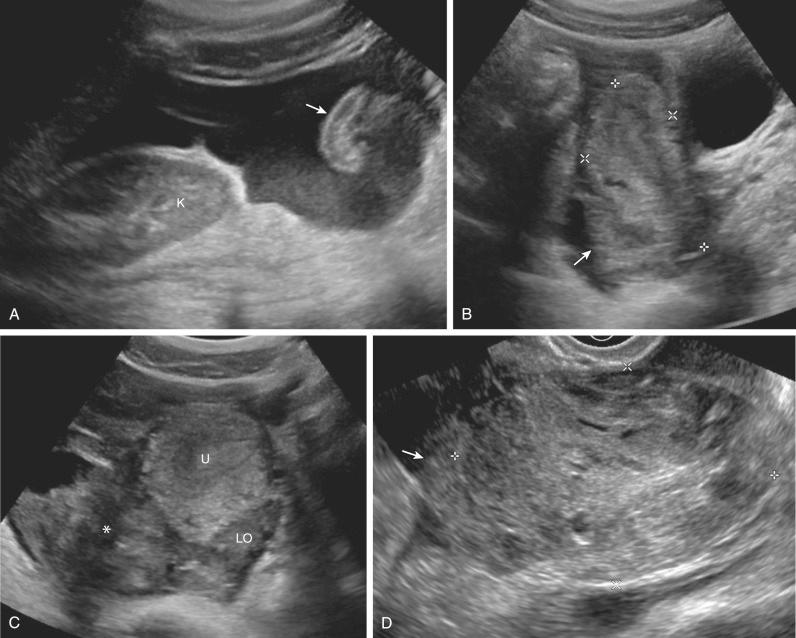
As with all ultrasound applications, it is standard practice to use the highest possible transducer frequency that allows visualization of the target organs. During TAS, visualization of the pelvic organs is typically limited by sound attenuation by the intervening anterior abdominal wall and subcutaneous and preperitoneal fat, as well as fat in the mesentery and omentum. As a result of this attenuation and the distance of the area of interest from the anterior abdominal wall, it is often not possible to use transducers with frequencies above 6 MHz for TAS, unless the patient is very thin. TVS is typically performed using a probe of 7.5 MHz or higher frequency, taking advantage of the ability to place the probe closer to the pelvic organs because of fewer intervening structures and resulting in less sound attenuation.
The patient should void immediately before the transvaginal examination so that the urinary bladder is as empty as possible. This will improve visualization of the reproductive organs, especially the adnexal structures, which may be displaced out of the pelvis when the bladder is distended, and will reduce patient discomfort. The sonologist or sonographer should obtain a pertinent history from the patient, explain the rationale for performing the TVS as well as how the examination is performed, and obtain verbal consent before beginning the examination. If a male sonologist or sonographer is to perform the examination, a female staff member (an aide, nurse, or other staff member) should be present in the room for the entire transvaginal examination to act as a chaperone. Consideration of having a chaperone present for all TVS, even if performed by a female, should be in accordance with local policy and is recommended in some institutions. The patient should be positioned as comfortably as possible in the lithotomy position using either a gynecologic examination table with stirrups or by placing cushions or folded linens underneath the buttocks to elevate and abduct the hip region. The patient should be appropriately covered and draped, and the examination should be conducted with the same respect for privacy afforded patients during the performance of a bimanual pelvic examination.
To prevent the spread of infectious disease, the transvaginal probe should be appropriately disinfected using high-level disinfection protocols between uses according to the manufacturers' and Occupational Safety and Health Administration (OSHA) recommendations. Following disinfection, the probe is wiped clean, and either a small amount of transducer coupling gel is placed inside a probe cover or a pregelled probe cover is placed over the probe. Because of concern for latex allergies, many laboratories use nonlatex probe covers for all patients. Care is taken to minimize air bubbles over the transducer face when applying the probe cover, and if they are noted, the probe cover should be readjusted. The final step in the process of probe preparation is to lubricate the tip of the covered probe with a sterile, nonspermicidal lubricant. Individual packets are preferred over large multiuse containers to minimize the potential for contamination of the gel and reduce the risk of transmission of infection. The sonographer should wear gloves while preparing the probe and performing the examination.
Become a Clinical Tree membership for Full access and enjoy Unlimited articles
If you are a member. Log in here